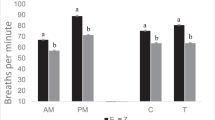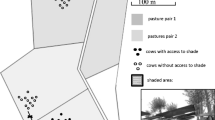Abstract
Experiments were conducted to evaluate strategies designed to reduce heat stress of cattle. In the first experiment, cattle were sprinkled for 20 min every 1.5 h between 1000 hours and 1750 hours (WET) versus not sprinkled (DRY). In a second experiment, treatments consisted of: (1) control, no water application; (2) water applied to the pen surfaces between 1000 hours and 1200 hours (AM); and (3) water applied to pen surfaces between 1400 hours and 1600 hours (PM). In both experiments, sprinkling lowered (P < 0.05) mid-afternoon temperatures. In the first experiment, relative humidity (RH) of WET versus DRY pens differed (P < 0.05) and averaged 72.4 and 68.9%, respectively. The average temperature–humidity index (THI) in WET pens was 0.5 units lower (P < 0.05), than the THI in DRY pens. In the second experiment, RH in sprinkled pens was also greater (P < 0.05) than RH in control (CON) pens However, THI differed (P < 0.05) among treatments, being 81.5, 80.9, and 80.3, respectively for CON, AM, and PM. Pens with sprinklers had a larger percentage of steers in areas where sprinkling took place, even on days when sprinkling had not occurred. Based on differences in percentage of cattle panting in sprinkled and non-sprinkled treatments, sprinkling was found to have a positive effect on cattle feeding area microclimate and to reduce the susceptibility of cattle to hyperthermia. However, cattle acclimatization to being sprinkled can result in slight hyperthermia even during cooler days when sprinkling would normally not be utilized.
Similar content being viewed by others
References
Armstrong DV (1994) Heat stress interaction with shade and cooling. J Dairy Sci 77:2044–2050
Auvermann BW (2001) Recent developments in air pollution from cattle feedyards. In: Proceedings of Plains Nutrition Council Spring Conference, San Antonio, TX, 5–6 April 2001, pp 27–36
Baccari F Jr, Johnson HD, Hahn GL (1983) Environmental heat effects on growth, plasma T3, and postheat compensatory effects on Holstein calves. Proc Soc Exp Biol Med 173:312–318
Busby D, Loy D (1996) Heat stress in feedlot cattle: producer survey results. Beef Res Rep AS-632. Iowa State University, Ames, pp 108–110
Campbell GS, Jungbauer JD Jr, Bidlake WR, Hungerford RD (1994) Predicting the effect of temperature on soil thermal conductivity. Soil Sci 158:307–313
Chan SC, Huber JT, Chen KH, Simas JM, Wu Z (1997) Effects of ruminally inert fat and evaporative cooling on dairy cows in hot environmental temperatures. J Dairy Sci 80:1172–1178
Chen KH, Huber JT, Theurer CB, Armstrong DV, Wanderley RC, Simas JM, Chan SC, Sullivan JL (1993) Effect of protein quality and evaporative cooling on lactational performance of Holstein cows in hot weather. J Dairy Sci 76:819–825
Davis MS, Mader TL, Holt SM, Parkhurst AM (2003) Strategies to reduce feedlot cattle heat stress: effects on tympanic temperature. J Anim Sci 81:649–661
Ealy AD, Arechiga CF, Bray DR, Risco CA, Hansen PJ (1994) Effectiveness of short-term cooling and vitamin E for alleviation of infertility induced by heat stress in dairy cows. J Dairy Sci 77:3601–3607
Gonyou HW, Stricklin WR (1984) Diurnal patterns of feedlot bulls during winter and spring in northern latitudes. J Anim Sci 58:1075–1083
Hahn GL (1994) Environmental requirements of farm animals. In: Griffiths JF (ed) Handbook of agricultural meteorology. Oxford University Press, New York, pp 220–235
Hahn GL (1995) Environmental influences on feed intake and performance of feedlot cattle. In: Owens FN (ed) Proceedings of Intake by Feedlot Cattle Symposium. Oklahoma State University, Stillwater, pp 207–225
Hahn GL, Mader TL (1997) Heat waves and their relation to thermoregulation, feeding behavior and mortality of feedlot cattle. In: Proceedings of the 5th International Livestock Environment Symposium. ASAE, St. Joseph, MI, pp 563–567
Hubbard KG, Stooksbury DE, Hahn GL, Mader TL (1999) A climatological perspective on feedlot cattle performance and mortality related to the temperature–humidity index. J Prod Agric 12:650–653
Igono MB, Steevens BJ, Shanklin MD, Johnson HD (1985) Spray cooling effects on milk production, milk, and rectal temperature of cows during a moderate temperature summer season. J Dairy Sci 68:979–985
Kelly CF, Bond TE, Garrett W (1964) Heat transfer from swine to a cold slab. Trans ASAE 34–37
LCI (1970) Patterns of transit losses. Livestock Conservation, Omaha, NE
Lin JC, Moss BR, Koon JL, Flood CA, Rowe S, Martin JR, Brady B, Degraves F, Smith RC (1998) Effect of sprinkling over the feed area and misting free stalls on milk production. Prof Anim Sci 14:102–107
Mader TL (2003) Environmental stress in confined beef cattle. J Anim Sci 81(E Suppl 2):E110–E119
Mader TL, Davis MS (2004) Effect of management strategies on reducing heat stress of feedlot cattle: feed and water intake. J Anim Sci 82:3077–3087
Mader TL, Dahlquist JM, Gaughan JB (1997) Wind protection and airflow patterns in outside feedlots. J Anim Sci 75:26–36
Mader TL, Dahlquist JM, Hahn GL, Gaughan JB (1999a) Shade and wind barrier effects on summertime feedlot cattle performance. J Anim Sci 77:2065–2072
Mader TL, Gaughan JB, Young BA (1999b) Feedlot diet roughage level for Hereford cattle exposed to excessive heat load. Prof Anim Sci 15:53–62
Mader TL, Holt SM, Hahn GL, Davis MS, Spiers DE (2002) Feeding strategies for managing heat load in feedlot cattle. J Anim Sci 80:2373–2382
Monty DE, Garbareno JL (1978) Behavioral and physiological responses of Holstein-Friesian cows to high environmental temperatures and artificial cooling in Arizona. Am J Vet Res 39:877–882
Morrison SR, Givens RL, Lofgreen GP (1973) Sprinkling cattle for relief from heat stress. J Anim Sci 36:428–431
Morrison SR, Prokop M, Lofgreen GL (1981) Sprinkling cattle for heat stress relief. Activation temperature, duration of sprinkling, and pen area sprinkled. Trans Am Soc Agric Eng 24:1299–1300
NOAA (1976) Livestock hot weather stress. Operations Manual Letter C-31-76. NOAA, Kansas City, MO
Reinhardt CD, Brandt RT (1994) Effect of morning vs evening feeding of limit-fed Holsteins during summer months. In: Cattlemen’s Day Rep. 704. Kansas State Agricultural Experiment Station, Manhattan, pp 38–39
Sepaskhah AR, Boersma L (1979) Thermal conductivity of soils as a function of temperature and water content. Soil Sci Soc Am J 43:439–444
Tarazón-Herrera MJ, Huber T, Santos J, Mena M, Nusso L, Nussio C (1999) Effects of bovine somatotropin and evaporative cooling plus shade on lactation performance of cows during summer heat stress. J Dairy Sci 82:2352–2357
Thom EC (1959) The discomfort index. Weatherwise 12:57–59
Wiersma FD, Stott GH (1966) Microclimate modification for hot-weather stress relief of dairy cattle. Trans Am Soc Agric Eng 309–313
Wiersma F, Ray D, Roubicek C (1973) Modified environment for beef in hot climates. Trans Am Soc Agric Eng 16:348–353
Wolfenson D, Flamenbaum I, Berman A (1988) Dry period heat stress relief effects on prepartum progesterone, calf birth weight, and milk production. J Dairy Sci 71:809–818
Acknowledgements
Contributions of the University of Nebraska, Agricultural Research Division, Lincoln, NE 68583. Partial research support provided by the Office of Science (BER), United States Department of Energy, Cooperative Agreement No. DE-FCO2-03ER63613
Author information
Authors and Affiliations
Corresponding author
Rights and permissions
About this article
Cite this article
Mader, T.L., Davis, M.S. & Gaughan, J.B. Effect of sprinkling on feedlot microclimate and cattle behavior. Int J Biometeorol 51, 541–551 (2007). https://doi.org/10.1007/s00484-007-0093-8
Received:
Revised:
Accepted:
Published:
Issue Date:
DOI: https://doi.org/10.1007/s00484-007-0093-8




